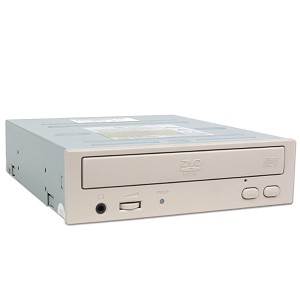DVD (also known as "Digital Versatile Disc" or "Digital Video Disc") is a popular optical disc storage media format used for data storage. Primarily uses are for movies, software, and data backup purposes, DVDs are of the same form factor as compact discs (CDs), but allow for 8 times the data storage capacity (single-layer, single-sided).
All read-only DVD discs, regardless of type, are DVD-ROM discs. This includes replicated (factory pressed), recorded (burned), video, audio, and data DVDs. A DVD with properly formatted and structured video content is a DVD-Video disc. DVDs with properly formatted and structured audio content are DVD-Audio discs. Everything else, (including other types of DVD discs with video content) is referred to as a DVD-Data disc. Consumers use the term "DVD-ROM" to refer to pressed data discs only, but that is incorrect usage; moreover, the term DVD is also applied generically in describing newer video disc formats, Blu-ray Disc and HD DVD.
Optical disc
Optical disc image
Recorder hardware
Authoring software
Recording technologies
- Recording modes
Packet writing
Laserdisc
Compact Disc/CD-ROM: CD-R, CD-RW
MiniDisc
DVD: DVD-R, DVD-D, DVD-R DL, DVD+R, DVD+R DL, DVD-RW, DVD+RW, DVD-RW DL, DVD+RW DL, DVD-RAM
Blu-ray Disc: BD-R, BD-RE
HD DVD: HD DVD-R: HD DVD-RAM
UDO
UMD
Holographic data storage
3D optical data storage
History of optical storage media
Rainbow Books
File systems
- ISO 9660
- Joliet
Rock Ridge
- Amiga Rock Ridge extensions
El Torito
Apple ISO9660 Extensions
Universal Disk Format
- Mount Rainier
 History
History
"DVD" was originally used as an initialism for the unofficial term "digital videodisk". The official DVD specification documents have never defined DVD. Usage in the present day varies, with "DVD", "Digital Video Disc", and "Digital Versatile Disc" all being common.
Etymology
The 12cm type is a standard DVD, and the 8cm variety is known as a mini-DVD. These are the same sizes as a standard CD and a mini-CD, respectively.
Note: GB here means gigabyte, equal to 10 (or 1,073,741,824) bytes.
Example: A disc with 8.5 GB capacity is equivalent to: (8.5 × 1,000,000,000) / 1,073,741,824 ≈ 7.92 GiB.
Size Note: There is a difference in size between + and - DL DVD formats. For example, the 12 cm single sided disk has capacities:
Capacity nomenclature
DVD uses 650 nm wavelength laser diode light as opposed to 780 nm for CD. This permits a smaller spot on the media surface that is 1.32 µm for DVD while it was 2.11 µm for CD.
Writing speeds for DVD were 1x, that is 1350 kB/s (≈1.32 MiB/s), in first drives and media models. More recent models at 18x or 20x will have 18 or 20 times that speed. Note that for CD drives, 1x means 153.6 kB/s (150 KiB/s), 9 times slower. DVD FAQ
 Technology
Technology
Main article: DVD recordable
HP initially developed recordable DVD media from the need to store data for back-up and transport.
DVD recordables are now also used for consumer audio and video recording. Three formats were developed: -R/RW (minus/dash), +R/RW (plus), -RAM (which is strictly speaking not random access memory).
DVD recordable and rewriteable
Dual Layer recording allows DVD-R and DVD+R discs to store significantly more data, up to 8.5 Gigabytes per disc, compared with 4.7 Gigabytes for single-layer discs. DVD-R DL was developed for the DVD Forum by Pioneer Corporation, DVD+R DL was developed for the DVD+RW Alliance by Philips and Mitsubishi Kagaku Media (MKM). Many current DVD recorders support dual-layer technology, and the price is comparable to that of single-layer drives, though the blank media remain significantly more expensive.
Dual layer recording
- Mount Rainier
- Amiga Rock Ridge extensions
- Joliet
- ISO 9660
 Lefthit
Lefthit
No comments:
Post a Comment